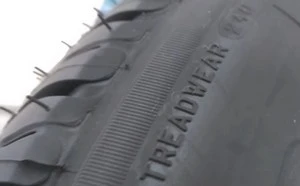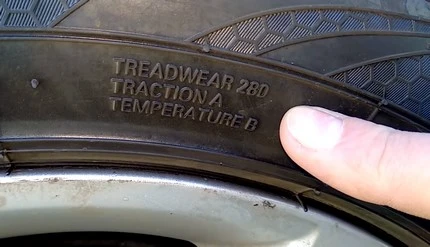
When choosing a tire, almost every car owner wonders «how long they can be driven for». To find out how long a tire will last before it wears out is part of the regulation called the automobile tire certification for sale in the United States. Uniform Tire Quality Grading (UTQG) performance data is indicated on the side of the tire and encoded by the Treadwear symbol.
The three-digit number of the Treadwear Index is a measure of a specific tire's resistance to wear. This is the index which allows the driver to calculate how much mileage the tires are designed to cover, taking into account the individual peculiarities of vehicle use. You may use the formula for calculating the tire's wear or take advantage of our tire life calculator, which will give you the approximate mileage.
How to determine the service life
To calculate the tire's durability and wear resistance you need to convert the specified Treadwear wear index to the reference kilometrage data. So 200 corresponds to 96,500 kilometres travelled against a reference tire under ideal conditions of humidity, temperature, road surface and speed. Consequently, it's very different from real-world performance.
In order to know how many kilometers your tires will run before they are worn out, you need a correction factor which takes into account your driving style and the road conditions.
Tire Wear Conversion Formula
The formula for tire wear in ideal conditions is as follows:
Mileage = Treadwear * 483,
where 1 unit = 483 km of mileage (reference).
Adjusting for track conditions, the tire's treadwear life is calculated as follows:
Real mileage = (Treadwear * 483)/k,
where k = service wear factor.
What should the coefficient be?
Assume that in good conditions of use with careful driving the real mileage will be at least twice as low. When there are defects in the road surface, and the speed mode can change quickly (dynamic city driving), the correction factor may increase up to 5. Everyone selects the appropriate value for themselves, depending on their driving style, driving conditions, etc. The disgusting pavement with a huge number of potholes and heterogeneous abrasive pavement, and even dense urban traffic will reduce the life of the tire about 5 times!
Treadwear Tire Wear Index Chart
| Tire Wear Index (Treadwear) | Average tire life (km) |
|---|---|
| Sports | |
| 150 | 18 |
| 200 | 24 |
| Regular tires (comfort) | |
| 240 | 38 |
| 300 | 48 |
| 320 | 51 |
| 380 | 61 |
| Eco tires | |
| 400 | 64 |
| 420 | 67 |
| 500 | 80 |
| 570 | 91 |
However, it should be noted that a higher index does not mean a better or more durable tire, because you should consider not only the index as a separate indicator, but also such parameters as:

- Traction (A, B, C, D) — the tire's grip on wet roads;
- TEMPERATURE (A, B, C) — heat resistance at high speed.
In both cases, «A» is best. All these three indicators are interconnected, and if Treadwear is big, such rubber will have worse grip and will wear out faster when heated.Thus, the golden mean is 240-280, because they will work much better at high speeds (acceleration, road holding, braking). It is this figure that the premium brands focus on. Such rubber has an average mileage of 40-45 thousand km. Which is just enough for the entire life of the tire.
How to use the online mileage calculator
To calculate how long tires with this or that treadwear index run is quite simple. It is enough to determine the peculiarities of the use of the car in order to pick up the correction factor of wear, the more the load on the tires (vehicle overloading, speed, road quality, ambient temperature) the higher it is. As a rule it is 3, 4 or 5. And then enter the number of Treadwear, which is indicated on the tire. That is:
- Mark the percentage of vehicle use relative to city driving (the higher the percentage, the more wear and tear);
- Enter in the «Treadwear Index» field the number indicated on the tire;
- In the field «Tires designed for mileage» you will see the approximate value of the service life by kilometer.